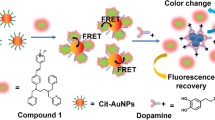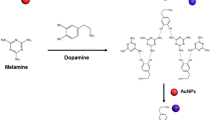Abstract
The authors describe an optical method for the determination of dopamine (DA). It is based on the use of gold nanorods (AuNRs) with an aspect ratio of 3.2 and an absorption maximum at 700 nm. The AuNRs were synthesized via a seed-mediated growth route. The addition of various DA concentrations to the aqueous AuNRs results in a color change bluish-purple to colorless. The addition of DA is accompanied by a linear decrease in absorbance, a blue-shift of the peak to 687 nm, and the formation of a new band peaking at 720 nm on increasing in the DA concentration to 100 μM. It is found that DA causes an aggregation of the AuNRs through the formation of interparticle plasmon-linkages between DA molecules and AuNRs. This was confirmed by transmission electron microscopy. This new colorimetric probe for DA shows good selectivity for DA even in the presence of potentially interfering species. Several linearranges are observed between the changes in absorption at around 687 and at around 720 nm and the DA concentration in the range between 100 nM and 10 mM. The limit of detection is 30 nM. The method was successfully employed to the determination of DA in spiked human urine samples.

Schematic of a reliable, highly selective, and sensitive method for the detection of dopamine using the localized surface plasmon resonance of bare gold nanorods.






Similar content being viewed by others
References
Dong Y, Chen X, Li C, Chen X (2009) MEEKC with laser induced fluorescence detection of epinephrine and dopamine in TCM and in plasma of patients with rheumatic heart disease. J Lanzhou Univ (Natur Sci) 45:77–81
Gingrich JA, Caron MG (1993) Recent advances in the molecular biology of dopamine receptors. Annu Rev Neurosci 16(1):299–321
Farde L (1997) Brain imaging of schizophrenia—the dopamine hypothesis. Schizophr Res 28(2–3):157–162
Wightman RM, May LJ, Michael AC (1988) Detection of dopamine dynamics in the brain. Anal Chem 60(13):769A–793A
Bouloux P, Perrett D, Besser G (1985) Methodological considerations in the determination of plasma catecholamines by high-performance liquid chromatography with electrochemical detection. Ann Clin Biochem: J Biochem Med 22(2):194–203
Li L, Liu H, Shen Y, Zhang J, Zhu J-J (2011) Electrogenerated chemiluminescence of Au nanoclusters for the detection of dopamine. Anal Chem 83(3):661–665
Olefirowicz TM, Ewing AG (1990) Dopamine concentration in the cytoplasmic compartment of single neurons determined by capillary electrophoresis. J Neurosci Methods 34(1):11–15
Wu L, Feng L, Ren J, Qu X (2012) Electrochemical detection of dopamine using porphyrin-functionalized graphene. Biosens Bioelectron 34(1):57–62
Pandikumar A, How GTS, See TP, Omar FS, Jayabal S, Kamali KZ, Yusoff N, Jamil A, Ramaraj R, John SA (2014) Graphene and its nanocomposite material based electrochemical sensor platform for dopamine. RSC Adv 4(108):63296–63323
Su H, Sun B, Chen L, Xu Z, Ai S (2012) Colorimetric sensing of dopamine based on the aggregation of gold nanoparticles induced by copper ions. Anal Methods 4(12):3981–3986
Yusoff N, Pandikumar A, Ramaraj R, Lim HN, Huang NM (2015) Gold nanoparticle based optical and electrochemical sensing of dopamine. Microchim Acta 182(13–14):2091–2114
Jayabal S, Pandikumar A, Lim HN, Ramaraj R, Sun T, Huang NM (2015) A gold nanorod-based localized surface plasmon resonance platform for the detection of environmentally toxic metal ions. Analyst 140(8):2540–2555
Zheng Y, Wang Y, Yang X (2011) Aptamer-based colorimetric biosensing of dopamine using unmodified gold nanoparticles. Sensors Actuators B Chem 156(1):95–99
Zhang Y, Li B, Chen X (2010) Simple and sensitive detection of dopamine in the presence of high concentration of ascorbic acid using gold nanoparticles as colorimetric probes. Microchim Acta 168(1–2):107–113
Kong B, Zhu A, Luo Y, Tian Y, Yu Y, Shi G (2011) Sensitive and selective colorimetric visualization of cerebral dopamine based on double molecular recognition. Angew Chem 123(8):1877–1880
Chen Z, Zhang C, Zhou T, Ma H (2015) Gold nanoparticle based colorimetric probe for dopamine detection based on the interaction between dopamine and melamine. Microchim Acta 182(5–6):1003–1008
Chen Z, Zhang C, Wang C (2015) A colorimetric assay of dopamine utilizing melamine modified gold nanoparticle probes. Anal Methods 7(3):838–841
Yu Y-Y, Chang S-S, Lee C-L, Wang CC (1997) Gold nanorods: electrochemical synthesis and optical properties. J Phys Chem B 101(34):6661–6664
N’Gom M, Li S, Schatz G, Erni R, Agarwal A, Kotov N, Norris TB (2009) Electron-beam mapping of plasmon resonances in electromagnetically interacting gold nanorods. Phys Rev B 80(11):113411
Chen H, Shao L, Li Q, Wang J (2013) Gold nanorods and their plasmonic properties. Chem Soc Rev 42(7):2679–2724
Thomas KG, Barazzouk S, Ipe BI, Joseph SS, Kamat PV (2004) Uniaxial plasmon coupling through longitudinal self-assembly of gold nanorods. J Phys Chem B 108(35):13066–13068
Mackey MA, Ali MR, Austin LA, Near RD, El-Sayed MA (2014) The most effective gold nanorod size for plasmonic photothermal therapy: theory and in vitro experiments. J Phys Chem B 118(5):1319–1326
Nikoobakht B, El-Sayed MA (2003) Preparation and growth mechanism of gold nanorods (NRs) using seed-mediated growth method. Chem Mater 15(10):1957–1962
Bang NA, Thom PT, Nhat HN (2013) A comparative study of classical approaches to surface plasmon resonance of colloidal gold nanorods. Gold Bull 46(2):91–96
Jayabal S, Viswanathan P, Ramaraj R (2014) Reduced graphene oxide–gold nanorod composite material stabilized in silicate sol–gel matrix for nitric oxide sensor. RSC Adv 4(63):33541–33548
Feng J-J, Guo H, Li Y-F, Wang Y-H, Chen W-Y, Wang A-J (2013) Single molecular functionalized gold nanoparticles for hydrogen-bonding recognition and colorimetric detection of dopamine with high sensitivity and selectivity. ACS Appl Mater Interfaces 5(4):1226–1231
Homola J (2008) Surface plasmon resonance sensors for detection of chemical and biological species. Chem Rev 108(2):462–493
Lin Y, Chen C, Wang C, Pu F, Ren J, Qu X (2011) Silver nanoprobe for sensitive and selective colorimetric detection of dopaminevia robust Ag–catechol interaction. Chem Commun 47(4):1181–1183
Kamali KZ, Pandikumar A, Sivaraman G, Lim HN, Wren SP, Sun T, Huang NM (2015) Silver@graphene oxide nanocomposite-based optical sensor platform for biomolecules. RSC Adv 5(23):17809–17816
Shibu Joseph S, Ipe BI, Pramod P, Thomas KG (2006) Gold nanorods to nanochains: mechanistic investigations on their longitudinal assembly using α, ω-alkanedithiols and interplasmon coupling. J Phys Chem B 110(1):150–157
Maduraiveeran G, Ramaraj R (2011) Silver nanoparticles embedded in amine-functionalized silicate sol–gel network assembly for sensing cysteine, adenosine and NADH. J Nanopart Res 13(9):4267–4276
Radhakumary C, Sreenivasan K (2011) Naked eye detection of glucose in urine using glucose oxidase immobilized gold nanoparticles. Anal Chem 83(7):2829–2833
Xue Y, Zhao H, Wu Z, Li X, He Y, Yuan Z (2011) Colorimetric detection of Cd 2+ using gold nanoparticles cofunctionalized with 6-mercaptonicotinic acid and l-cysteine. Analyst 136(18):3725–3730
Kamali KZ, Pandikumar A, Jayabal S, Ramaraj R, Lim HN, Ong BH, Bien CSD, Kee YY, Huang NM (2016) Amalgamation based optical and colorimetric sensing of mercury (II) ions with silver@graphene oxide nanocomposite materials. Microchim Acta 183(1):369–377
Liu J-M, Wang X-X, Cui M-L, Lin L-P, Jiang S-L, Jiao L, Zhang L-H (2013) A promising non-aggregation colorimetric sensor of AuNRs–Ag+ for determination of dopamine. Sensors Actuators B Chem 176:97–102
Wang B, Chen Y, Wu Y, Weng B, Liu Y, Li CM (2016) Synthesis of nitrogen- and iron-containing carbon dots, and their application to colorimetric and fluorometric determination of dopamine. Microchim Acta 183(9):2491–2500
Acknowledgements
This work was financially supported by a University of Malaya Research Grant UMRG programme (RP007C-13AFR) and the High Impact Research Grant from the Ministry of Higher Education of Malaysia (UM.C/625/1/HIR/MOHE/05).
Author information
Authors and Affiliations
Corresponding authors
Ethics declarations
The author(s) declare that they have no competing interests.
Rights and permissions
About this article
Cite this article
Teo, P.S., Rameshkumar, P., Pandikumar, A. et al. Colorimetric and visual dopamine assay based on the use of gold nanorods. Microchim Acta 184, 4125–4132 (2017). https://doi.org/10.1007/s00604-017-2435-5
Received:
Accepted:
Published:
Issue Date:
DOI: https://doi.org/10.1007/s00604-017-2435-5




